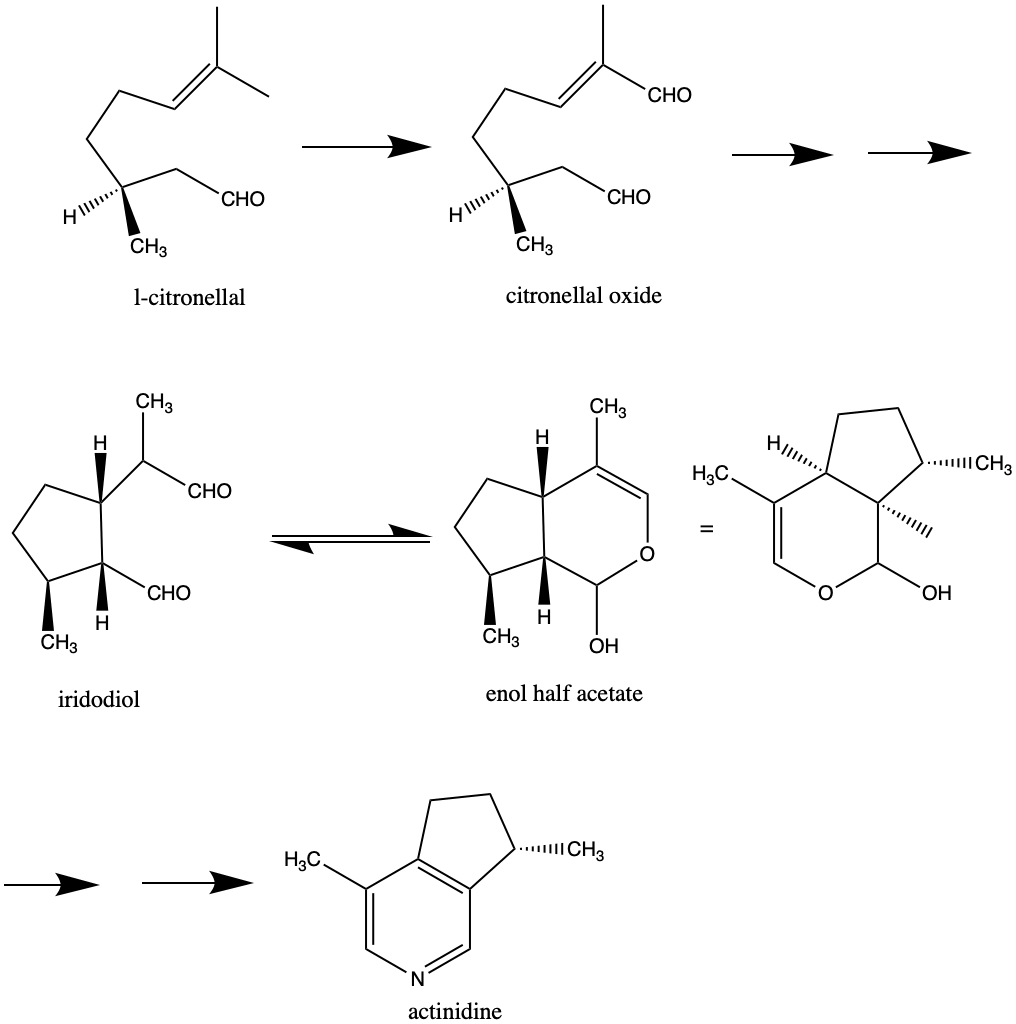Actinidine on:
[Wikipedia]
[Google]
[Amazon]
Actinidine is an

iridoid
Iridoids are a type of monoterpenoids in the general form of cyclopentanopyran, found in a wide variety of plants and some animals. They are biosynthetically derived from 8-oxogeranial. Iridoids are typically found in plants as glycosides, mo ...
produced in nature by a wide variety of plants and animals. It was the first cyclopentanoid monoterpene
Monoterpenes are a class of terpenes that consist of two isoprene units and have the molecular formula C10H16. Monoterpenes may be linear (acyclic) or contain rings (monocyclic and bicyclic). Modified terpenes, such as those containing oxygen func ...
alkaloid to be discovered. It is one of several compounds that may be extracted from the valerian (''Valeriana officinalis'') root and silver vine (''Actinidia polygama
''Actinidia polygama'' (also known as silver vine, matatabi and cat powder) is a species of kiwifruit in the family Actinidiaceae. It grows in the mountainous areas of Korea, Japan and China at elevations between .
Name
In Korean, ''A. polyga ...
''), as well as several types of insects in the larval
A larva (; : larvae ) is a distinct juvenile form many animals undergo before metamorphosis into their next life stage. Animals with indirect development such as insects, some arachnids, amphibians, or cnidarians typically have a larval phase ...
and imaginal stages. Actinidine is a cat attractant
A cat pheromone is a chemical molecule, or compound, that is used by cats and other felidae, felids for communication. These pheromones are produced and detected specifically by the body systems of cats and evoke certain behavioural responses.
Cat ...
, with effects like those of nepetalactone
Nepetalactone is a name for multiple iridoid Structural analog, analog stereoisomers. Nepetalactones are produced by ''Nepeta cataria'' (catnip) and many other plants belonging to the genus ''Nepeta'', in which they protect these plants from herbiv ...
, the active compound found in catnip
''Nepeta cataria'', commonly known as catnip and catmint, is a species of the genus ''Nepeta'' in the mint family, native plant, native to southern and eastern Europe, northern parts of the Middle East, and Central Asia. It is widely naturalis ...
.
Certain species of stick insects
The Phasmatodea (also known as Phasmida or Phasmatoptera) are an order of insects whose members are variously known as stick insects, stick bugs, walkingsticks, stick animals, or bug sticks. They are also occasionally referred to as Devil's dar ...
, including '' Megacrania batesii'' and '' Megacrania tsudai'', possess a chemical defense
Chemical defense is a strategy employed by many organisms to avoid consumption by producing toxic or repellent metabolites or chemical warnings which incite defensive behavioral changes. The production of defensive chemicals occurs in plants, fung ...
mechanism which involves the secretion of an actinidine-containing substance from the prothoracic
The prothorax is the foremost of the three segments in the thorax of an insect, and bears the first pair of legs. Its principal sclerites (exoskeletal plates) are the pronotum (dorsal), the prosternum (ventral), and the propleuron (lateral) on ea ...
glands, when threatened by a predator.
Biosynthesis
A potential biosynthesis of actinidine from - citronellal is shown below.{{cite book, chapter=14: Alkaloids Derived from Terpenoids , editor-first=Shinji , editor-last=Funayama , editor2-first=Geoffrey A. , editor2-last=Cordell , title=Alkaloids , publisher=Academic Press , date=2015 , pages=233–255
References